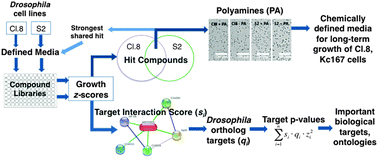An inverse small molecule screen to design a chemically defined medium supporting long-term growth of Drosophila cell lines†
Abstract
Drosophila cell culture is used as a model system with multiple applications including the identification of new therapeutic targets in screens, the study of conserved signal transduction pathway mechanisms, and as an expression system for recombinant proteins. However, in vitro methods for Drosophila cell and organ cultures are relatively undeveloped. To characterize the minimal requirements for long-term maintenance of Drosophila cell lines, we developed an inverse screening strategy to identify small molecules and synergies stimulating proliferation in a chemically defined medium. In this chemical-genetics approach, a compound–protein interaction database is used to systematically score genetic targets on a screen-wide scale to extract further information about cell growth. In the pilot screen, we focused on two well-characterized cell lines, Clone 8 (Cl.8) and Schneider 2 (S2). Validated factors were investigated for their ability to maintain cell growth over multiple passages in the chemically defined medium (CDM). The polyamine spermidine proved to be the critical component that enables the CDM to support long-term maintenance of Cl.8 cells. Spermidine supplementation upregulates DNA synthesis for Cl.8 and S2 cells and increases MAPK signaling for Cl.8 cells. The CDM also supports the long-term growth of Kc167 cells. Our target scoring approach validated the importance of polyamines, with enrichment for multiple polyamine ontologies found for both cell lines. Future iterations of the screen will enable the identification of compound combinations optimized for specific applications—maintenance and generation of new cell lines or the production and purification of recombinant proteins—thus increasing the versatility of Drosophila cell culture as both a genetic and biochemical model system. Our cumulative target scoring approach improves on traditional chemical-genetics methods and is extensible to biological processes in other species.


 Please wait while we load your content...
Please wait while we load your content...